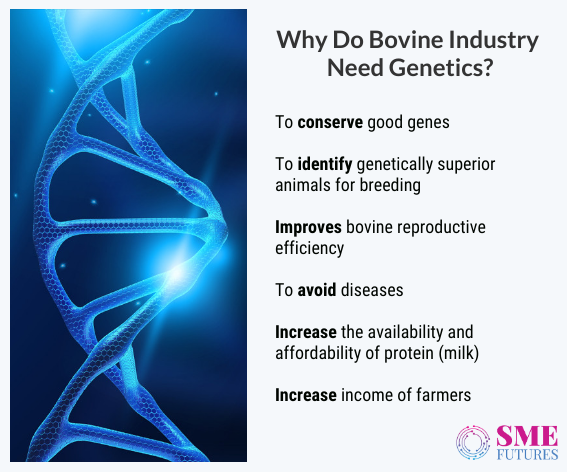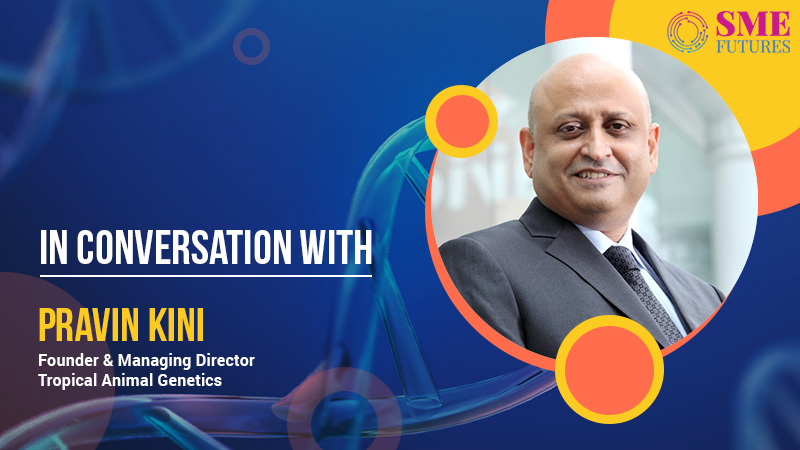India, being the world’s leading milk producing country, contributes at least one-fourth of the value output of the entire agriculture sector. Hence, the government views this sector as a key driver for doubling the farmer’s income by 2022. Over few years, the growth is sluggish due to challenges in this unorganised sector. Such challenges include an uneven male-female animal ratio resulting in stray cattle and lack of awareness about the standing cost of animals required for breeding purposes.
Hence, the need of the hour is to overhaul the dairy sector using advanced technologies such as animal genetic techniques. The global animal genetic market is currently projected to grow by US$ 5.8 billion by 2023 at a rate of 6.5 per cent. However, animal genetics as a sector in India is on a nascent stage. One of the very few players in this sector is Tropical Animal Genetics. The company was established in 2014, and it was the first Indian company to use In Vitro Fertilizers—Embryo Transfer (IVF-ET) technology on an industrial scale.
TAG’s genetic technology services are helping the country’s bovine breeders and farmers to convert sexed embryos to an embryo derived from milch cow for sale to a dairy farmer. This way, it is creating a new breed of rural entrepreneurs and is generating employment opportunities for other villagers. In a tete-a-tete with SME Futures, Dr. Pravin Kini, Founder and Managing Director, Tropical Animal Genetics (TAG) talks more about the animal genetic industry in India and how it is creating a positive impact.
Edited excerpt
What according to you is the current scenario of India in the animal genetic market?
A burgeoning middle class, rapid urbanisation combined with the rising consumption of animal protein is a key driver of the growth of the animal genetics market in India. Although, United States are the current leader in this market, India is predicted to grow fastest in the animal health genetics market. The live animal segment looks promising with significant growth opportunities and an increase in farmers’ income as the usage of milk and meat increases.
In the near future, there will be an increasing adoption of various techniques such as in-vitro embryo production, and artificial insemination which will catalyse the market for genetic material. The coverage of artificial insemination in India is just about 35 per cent and therefore there is a long way to go. Our goal is to scale it up to 60-70 per cent.
In terms of Embryo Transfer Technology, it is just beginning with TAG producing the commercially saleable embryos to Indian dairy farmers. The current efforts have been in terms of isolated incidents for research and trial purposes.
How animal genetics is contributing in building agricultural sustainability in India? What is the role of TAG in it?
Identifying genetically superior animals for breeding purposes and adoption of assisted reproductive technologies ensures better genetics for the next generation of animals and increases productivity for each animal. This reduces the need for more animals. In such a situation, the country can produce more protein with less expense on finite resources such as land, water, and reduction of environmental footprint.
For example, cattle are one of the major sources of methane emissions in agriculture. By switching the ratio of productive animals to unproductive animals and increasing milk yield per animal, fewer animals would be required to meet the overall demand for milk. Animal genetics hence can ensure a higher feed conversion ratio for more productivity and sustainability.
Please throw some light on the challenges faced by animal genetic players in the sector. Are there any government schemes announced for the sector recently?
As part of their strategic growth initiatives, leading players are expanding their R&D infrastructure across the globe. However, there are very few indigenous players in India. The market is dominated by foreign giants. A lot of these foreign players have patents for their name and technologies they provide are not affordable for a marginal Indian farmer at the current price points. The government is supporting indigenous players by opening new R&D facilities in India and providing grants to create new genomics projects.
But there is still a lot of work left to do and more investment is needed in this space. Government is trying to partner with Indian innovators for bringing-in affordable technologies. However, the gradual opening of the breeding policies, protecting the local Indian breeds, and growing the indigenous milk production are key challenges that the government faces. However, at the small dairy farmer level, there are many central and state sponsored schemes to support them with capital, land, and subsidy and interest subvention.

India aims to double farmers income by 2022 and animal husbandry, more elaborately dairy sector can be of big help in achieving this. Do you think we are nearing that aim?
Doubling farmer income by 2022 is possible. Dairy is the lifeline of agro-based economy and is a dominant aspect in doubling farmer’s income. It holds several advantages over other livestock and agricultural products. Every 1 rupee invested in agriculture yields Rs 2.5 in agriculture but Rs. 5 in animal husbandry. Dairy farming is a crucial source of liquidity for farmers because it has predictable cash flow.
It has also proved to be a boon for small marginal farmers as it does not require infrastructure or high input. Animal genetics can ensure revenue and profits through increased productivity which makes dairy less risky and provides an additional source of income for even agricultural farmers. Reducing the feed costs, increasing procurement price, reducing the inter-calving periods are ways to reach this goal of doubling the farmer’s income.
Can you please elaborate on opportunities and challenges on innovation and infrastructure in the animal genetic market?
Innovators in India face challenges related to infrastructure of various kinds. Trained manpower is difficult to access, as they are mostly US and Europe centric. In terms of localising innovations and creating extremely affordable technologies, innovators face several bottlenecks. These include patent capital funding opportunities, initial partnerships, and first mover market entry challenges.
Since this sector does not have enough manpower, are there any initiatives on spreading awareness by TAG?
In India, there currently is a scarcity of trained embryologists, para-vets and other artificial insemination technicians. But with an increased demand for these technologies, numerous employment opportunities are being generated in this area with a variety of roles. TAG is supporting National Dairy Development Board (NDDB) and other institutions with specific curriculums surrounding artificial insemination, embryo production and transfers. Along with this, we have set up our own farm near Bangalore, where we could provide training for our AI technicians.
How do you deal with a general lack of awareness in this field among people of the dairy industry?
There is an increasing awareness about technologically advanced genetic products as well as an increased demand for high quality live animals. These challenges are the accessibility of these technologies and well-established distribution channels for genetic material. Since the pregnancy of cows requires 27 months before benefits of such technologies can be seen, the first adapters must be the government who can subsidize live animals and technologies.
Thereafter, they can provide them to farmers at a cheaper price range. Dairy farms could purchase pregnant animals and outsource breeding to breeder farmers who can convert embryos into milch cows. To reach out to fragmented small dairy farmers, only way for us is ‘to reach out to milk processors and milk cooperatives.’ These players are also focused on their priorities like the quantity of milk produced, cost reduction etc.
What kind of dairy players approach you since the services and products that you offer are mostly affordable?
There is a vast scope for improvement in the sector. Along with it, there is immense untapped potential due to low productivity and a large bovine population. TAG is uniquely designed to offer our products and services at a competitive price. We offer door-to-door services for both artificial insemination and embryo development. We also work with state governments, milk dairy cooperatives, commercial dairy farms as well as individual farmers. There is a lot of demand for our technologies and we are scaling up production as well as logistics in this.
What is the vision of TAG and which new services are you planning to offer in future?
TAG is positioned to become a leading player in the animal genetics space of India. It is working on scaling up embryo production. Some new research projects are also in the pipeline for streamlining artificial insemination and embryo transfers for farmers and service providers and increasing efficiency and productivity. Our research projects will also help to reduce the price point of our technologies further through scaled-up production. Moreover, we are also planning to launch genomics projects in poultry and aqua in the future.











